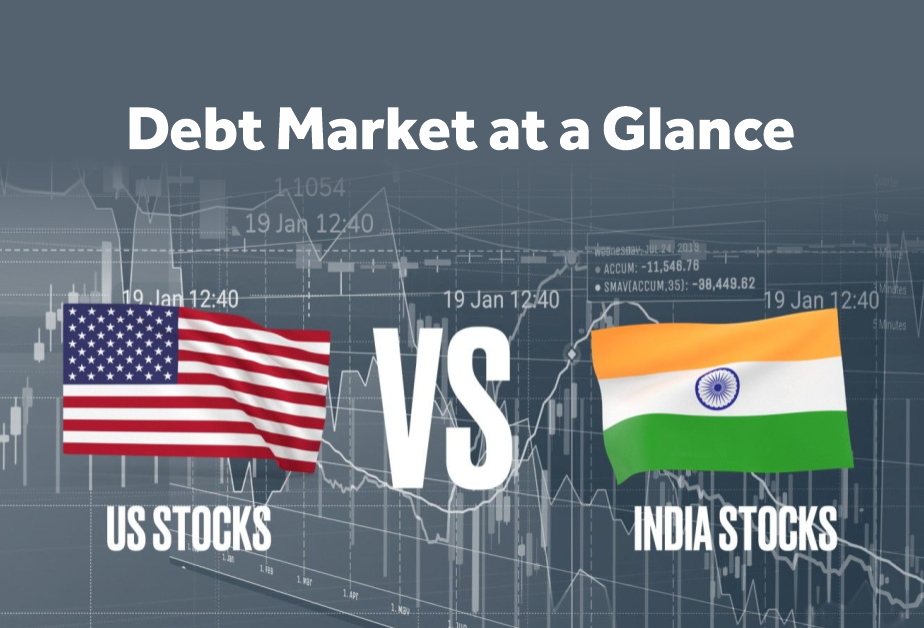Debt Market at a Glance - Indian markets vis-a-vis US markets

Debt Market at a Glance - Indian markets vis-a-vis US markets
There are varying profiles of Investors in the markets, quite a few of them with different risk appetites,returns expectations and having different views on the prospects of the financial markets. For example - In the case of a particular security, the buyer is buying the security expecting its price to go up, whereas the seller is selling the security expecting the price to either be stable or go down.
There is a market that is making rapid strides amongst retail Investors in India and that is the Debt securities / Fixed income securities market. Investing in debt securities may possibly fetch you lesser returns than stock markets, but correspondingly it reduces the volatility and risk of erosion of the principal capital invested.Investments in Debt securities may come out to be the best for the investors who like to play it slow and safe.The investors in fixed income securities follow the quote: ”Slow and steady wins the race”.
Debt markets, which form an important component of the global financial system, play a crucial role in enabling governments and corporations to raise funds. By issuing debt securities like bonds, these entities can secure the necessary funds for their various projects and operations.
The United States boasts one of the largest and most mature debt markets in the world. The U.S. bond market, with a total outstanding debt exceeding $46 trillion, is deeply liquid and diverse, encompassing government securities (Treasuries), municipal bonds, corporate bonds, and mortgage-backed securities.
In contrast, India's debt market is smaller, with an outstanding debt of around $2 trillion. The Indian debt market primarily comprises government securities, which dominate the landscape due to the significant borrowing needs of the central and state governments. The corporate bond market in India is relatively underdeveloped, with limited issuance and lower liquidity compared to government securities.
The regulatory environment in the United States is well-established, with multiple agencies overseeing various segments of the debt market. The U.S. Securities and Exchange Commission (SEC) regulates corporate bonds, while the Federal Reserve and the U.S. Department of the Treasury oversee government securities. This robust regulatory framework ensures transparency, investor protection, and market stability.
In India, the regulatory oversight is primarily the responsibility of the Reserve Bank of India (RBI) and the Securities and Exchange Board of India (SEBI). The RBI regulates the government securities market, while SEBI oversees the corporate bond market.
Recent reforms have aimed at enhancing market transparency, improving liquidity, and encouraging greater corporate bond issuance. However, regulatory challenges remain, particularly in fostering a more vibrant corporate bond market.
The U.S. debt market features a diverse array of participants, including institutional investors (such as pension funds, insurance companies, and mutual funds), foreign investors, and individual investors.
In India, institutional investors like banks, insurance companies, and mutual funds are the primary participants in the debt market. Foreign investment in Indian debt securities has been growing, particularly after regulatory relaxations to attract foreign portfolio investors (FPIs). However, the participation of individual investors remains limited due to lower awareness and limited access to market information.
Interest rates in the United States are closely watched globally, as they influence global financial conditions. The U.S. Federal Reserve's monetary policy decisions, particularly regarding the federal funds rate, have a significant impact on the yield curve, which serves as a benchmark for other debt securities. The U.S. yield curve is a critical indicator of economic sentiment, with an inverted yield curve is often seen as a precursor to economic recessions. In India, the yield curve is influenced by the RBI's monetary policy, which aims to balance economic growth with inflation control. Indian interest rates are generally higher than those in the U.S. due to factors such as higher inflation rates and different stages of economic development. The Indian yield curve is also shaped by the substantial borrowing requirements of the government, which can crowd out private investment.
India's debt market is in its early stages of embracing innovation. Recent initiatives include the introduction of electronic trading platforms for corporate bonds and efforts to develop a vibrant secondary market. The government's focus on infrastructure development and the push for financial inclusion are expected to drive future growth and innovation in the Indian debt market.
While the debt markets in India and the United States share the fundamental purpose of enabling fund raising, they differ significantly in terms of size, regulatory environment, market participants, interest rates, and innovation. The U.S. debt market, with its vast size and sophisticated infrastructure, sets a global benchmark. In contrast, India's debt market, though smaller and less developed, is on a growth trajectory, driven by regulatory reforms and increasing investor interest. As India continues to develop its financial markets, it can draw valuable lessons from the mature U.S. debt market to foster a more robust and dynamic debt market ecosystem.
#54ec- Capital-gain#AAA-Rated Bonds#Debentures#Bond Price Calculator#Capital Gain Bonds#Corporate Bonds#Covered Bonds#Deep-Discount Bonds#Fixed Income Bonds#Government Bonds#Municipal Bonds#Perpetual Bonds#PSU Bonds#RBI Bonds#Secured Bonds#Sovereign Gold Bonds#Tax Free Bonds.




